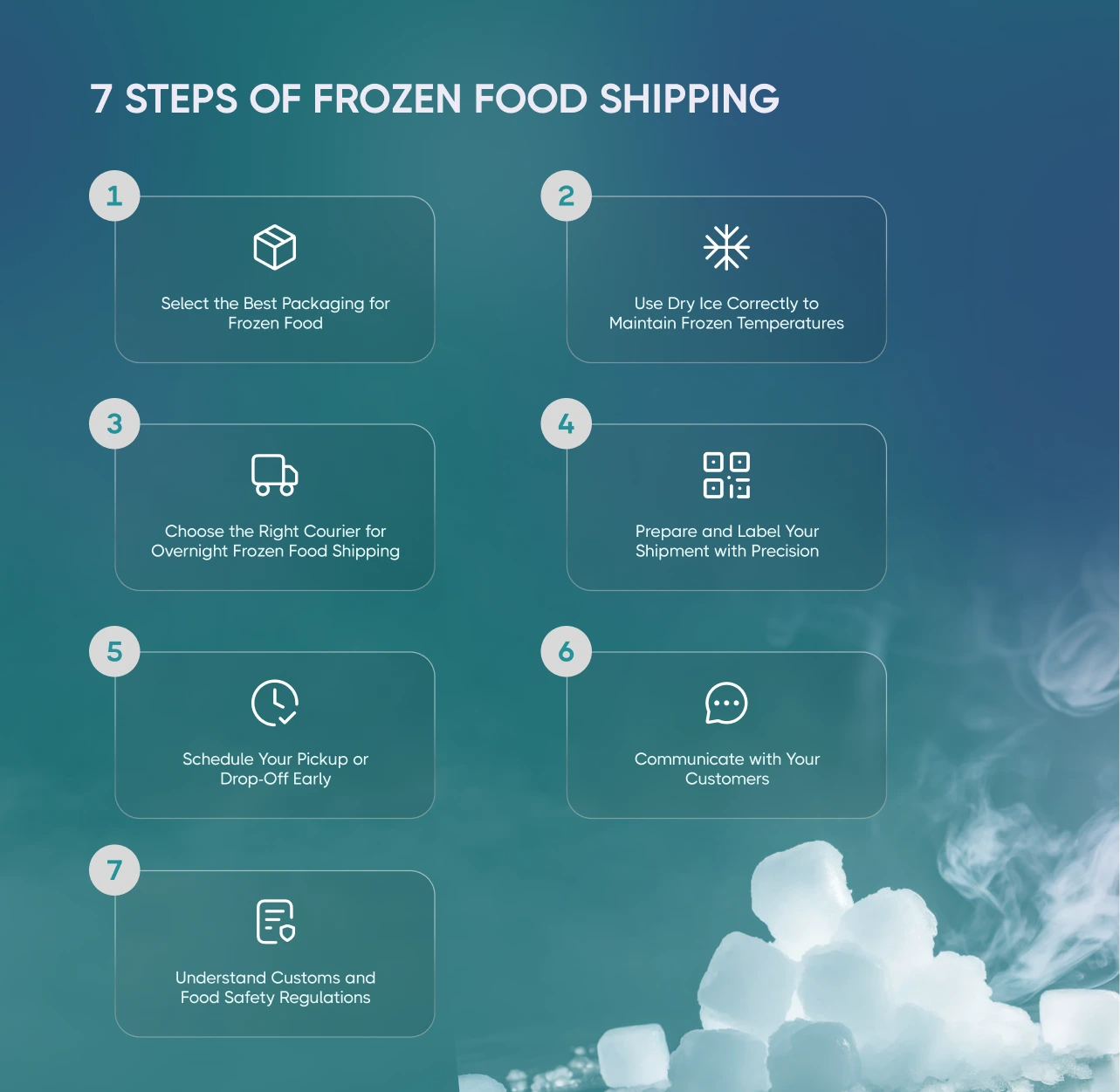
Sahiba Cuccria
8 mins read
10 mins read

Rizwan Datoo is a logistics and fulfillment consultant at eShipper specializing in D2C and B2B shipping solutions. He supports startups and established brands by simplifying complex shipping challenges and building efficient, reliable supply chains.

If you’re trying to ship frozen food overnight in Canada, you know it can be challenging.. Whether you sell frozen seafood on the Atlantic coast, bake artisanal frozen pastries in Quebec, or produce ready-to-eat frozen meals in Ontario, you can only ensure customer satisfaction if your products arrive frozen and fresh.
Infact, according to a recent report and Canada’s federal export records, Canada exported 202 shipments of frozen food to the U.S. from October 2023 to September last year. There was a 201% increase year over year, making the U.S. the ultimate destination for 100% of Canadian frozen food exports during that period.
If you are selling frozen goods on an eCommerce platform like Amazon or Walmart, you already know how high the stakes are. One small mistake in packaging, handling, or courier selection can lead to thawed goods, unhappy customers, and returns that can cost you your profit as a seller.So how do you get the process of frozen food shipping from Canada to the U.S. right? Well, what becomes extremely important is to work with a logistics partner who has the experience to handle it all for you
Working with a logistics partner like eShipper can help you navigate the process step-by-step, including:
Before we dive into the ‘How to’ of shipping frozen food overnight, let’s begin by first understanding why overnight shipping for frozen food should matter to you.
According to USDA, to maintain the quality of food and ensure it’s safe to consume, frozen food must stay below - 18°C (0°F). If the product thaws during transit, it can spoil, lose texture or flavor, or become unsafe to eat.
Overnight shipping minimizes the time your shipment is in transit and reduces the risk of thawing. This is critical for fresh seafood, desserts, meat, and other perishable frozen goods.
Here’s the Food Safety and Storage Table you can refer to as a seller, along with shipping considerations for each of these:
| Food Type | Safe Refrigerated Storage Before Shipping | Recommended Frozen Storage | Shipping Considerations for Sellers |
| Salads (Egg, chicken, ham, tuna, macaroni) | Up to 3 days | Not recommended | Ship fresh salads with expedited refrigerated shipping, avoid freezing to maintain texture. Use chilled packaging and refrigerate immediately upon arrival. |
| Hot Dogs | 1 week (opened), 2 weeks (unopened) | 1 to 2 months | Use insulated packaging and cold packs for refrigerated shipments; dry ice if frozen overnight. Label clearly as perishable. |
| Luncheon Meat | 3 to 5 days (opened), 2 weeks (unopened) | 1 to 2 months | Vacuum seal to maintain freshness; use dry ice for frozen shipments. Choose overnight courier to minimize transit time. |
| Bacon and Sausage | 1 week (bacon), 1 to 2 days (raw sausage) | 1 to 2 months | Fresh sausage requires fastest shipping; frozen sausage can be shipped with dry ice. Confirm courier’s dry ice policies via eShipper. |
| Ground Meats and Poultry | 1 to 2 days | 3 to 4 months | Always freeze ground meats before shipping frozen; package tightly with dry ice for overnight delivery. |
| Fresh Beef, Veal, Lamb, Pork | 3 to 5 days | 4 to 12 months | Freeze before shipping with adequate dry ice; use sturdy insulated boxes to prevent thawing during transit. |
| Ham | 3 to 7 days depending on type | 1 to 6 months | Check curing status; vacuum sealed hams ship better frozen; label clearly to assist handlers. |
| Fresh Poultry (Chicken, Turkey) | 1 to 2 days | 9 months to 1 year | Freeze fresh poultry prior to shipping; dry ice recommended for frozen shipments. Schedule earliest possible pickup. |
| Fish and Seafood | 1 to 4 days | 2 to 8 months | Use vacuum sealing and dry ice; ship overnight with specialized couriers experienced in perishables. |
| Shellfish (Crab, Lobster, Shrimp) | 1 to 5 days | 2 to 18 months | Live shellfish require fastest shipping, often refrigerated; frozen shellfish require dry ice and insulated packaging. |
| Eggs and Egg Products | 3 to 5 weeks for raw eggs in shell | Freeze yolks/whites separately | Do not freeze eggs in shell; ship refrigerated eggs quickly; frozen egg products require insulated packaging. |

The right packaging is the first step to making sure your frozen food shipment gets delivered safely. If you’re wondering how to pack frozen food for shipping, the right insulation and sealing techniques make all the difference. To keep the temperatures in control, follow these packaging best practices:
Insulated foam coolers or refrigerated shipping boxes provide the thermal barrier needed to keep your frozen food cold. These containers are widely available and are a cost-effective option.
Vacuum sealing removes air and moisture that can degrade your frozen food. If vacuum sealing is not an option, wrap items tightly in plastic wrap or freezer bags to prevent freezer burn and contamination.
Place your wrapped food inside the insulated container and fill empty spaces with cushioning material like bubble wrap or packing peanuts to prevent shifting during transit.
Seal the insulated container securely, then place it inside a sturdy cardboard box. Label the outer box with ‘Perishable – Keep Frozen’ message.
Dry ice is frozen carbon dioxide and is essential for keeping shipments frozen during overnight transportation. Always follow dry ice shipping guidelines to ensure safe handling and carrier compliance. Unlike regular ice, dry ice does not melt into water but sublimates into gas, making it ideal for long trips.
On an average, 5 to 10 pounds of dry ice disappears in 24 hours, depending on the packaging and of course the weather conditions. For instance, if you're shipping a box of frozen meat across the country, and it’s an overnight shipment, you’ll need at least 5 pounds of dry ice. If your box isn’t well insulated, you may need around 10 pounds of dry ice to keep your product frozen.
The exact amount depends on the package size, product type, and shipping duration.
When shipping overnight, plan for a minimum of 24 hours of cold retention.
Choosing the best couriers for frozen food in the market is extremely important. Not all carriers handle frozen shipments or dry ice the same way.
With eShipper, you get access to multiple carrier options including FedEx, UPS, Purolator, and DHL, all highly experienced with perishable goods and overnight delivery.
A multi-carrier platform allows you to compare carrier rates and delivery options tailored to your shipment needs.
Labeling your frozen food shipment clearly is a legal requirement and a practical necessity. Your labels should include:
Using a partner platform, you can generate compliant labels to reduce errors and speed up processing.
To ensure timely overnight delivery for your frozen food shipments, it’s important your products are with the carrier’s network early.
Schedule pickups or drop off your package at carrier locations as early in the day as possible, latest by 11 AM, if possible.
Frozen shipments need to be received promptly to avoid thawing after delivery. Communicate expected delivery windows and provide tracking information so customers can plan to accept the package immediately.
You can use a platform like eShipper that helps you not only compare multiple carriers for competitive rates but also offer real-time tracking options, especially necessary for frozen shipments. When dealing with overnight frozen food delivery, real-time tracking and precise customer notifications are crucial.
Cross-border frozen food shipments are subject to regulations. o avoid delays or penalties, it’s crucial to follow shipping compliance best practices.
Certain products such as meat, seafood, and dairy may require permits or certifications.
A platform like eShipper can help you with customs clearance support and prepare required documentation to avoid delays.
For a small chocolate business in Vancouver specialized in handcrafted truffles and dark chocolate bars made with organic ingredients, shipping across Canada wasn't a concern during the cooler months. But once temperatures started rising in late spring, they ran into a familiar challenge: melted products, which meant unhappy customers.
Their chocolates were being shipped with basic packaging with minimal insulation. Even with ice packs, several Calgary and Edmonton orders arrived partially or worse, completely melted. The packaging couldn’t withstand the heat during transit.
To solve this, they turned to eShipper to find a better shipping setup.
This helped them to:
They began using insulated mailers with cold packs and moisture barriers inside.
Deliveries were scheduled through the eShipper platform using the best available overnight weekday delivery carrier options to prevent weekend delays.
Pickup times were adjusted to late afternoon to reduce wait times for transit.
The chocolate brand experienced a noticeable drop in melt-related complaints. More importantly, they could continue selling through the summer, without needing to pause delivery operations or limiting delivery zones.
If your shipment thaws during transit, immediately contact your carrier and document the condition.
Keep your customers informed and be ready to offer replacements or refunds if necessary.
Perishable goods shipping from Canada, especially for frozen food, is complex but manageable with the right approach. By using insulated packaging, dry ice, trusted carriers, and support from expert shipping platforms eShipper, you can ensure your frozen products arrive fresh, frozen, and ready to delight your customers.
This reliability builds trust and loyalty, which are essential for growing your frozen food business.
Shipping costs depend on package size, weight, and destination. eShipper offers rate comparisons to help find competitive pricing that fits your budget.
FedEx does not provide packing services. You must prepare your frozen shipments following their dry ice and perishable goods guidelines.
Optimizing package size and weight, consolidating orders, and using eShipper’s platform to compare carrier rates can help you save money without sacrificing shipment quality.